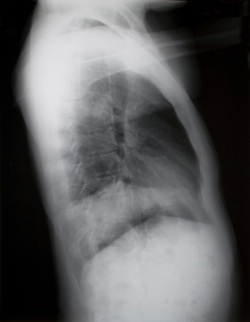Dust in the air can be a great danger to our respiratory system. Silicosis is a lung disease that can occur after being exposed for a longer time to dust containing quartz (eg. concrete). Recent studies have also determined the connection to lung cancer.
Which occupational groups are exposed to the hazard of silicosis?
Silicosis occurs especially with miners and labourers in quarries or with people working with natural stones.
Great danger within the construction industry
Also in the construction industry has the risk to develop silicosis (the black lung - as you can see on the picture) increased. This is due to the increasing use of more powerful grinding and milling equipment within concrete work, which release a large amount of very fine dust.
How does silicosis occur?
The silica particles have a size of ca. 0.5 µm and pass easily into the deepest recesses of the lung, where they are deposited. The human body reacts to these foreign objects with the so-called “antigen-antibody reaction”. This leads to a decay of the lung tissue with subsequent scarring as the silica particles bond into islands in the lung tissue.
Over time this leads to a reduced lung function, disability and even to lung cancer. The latency period can be up to 10 to 20 years before the first clinical symptoms are shown.
The symptons of silicosis include:
- Pain
- Irritating cough
- Shortness of breath
- And can lead to lung cancer
Various studies have indicated that the crystal forms of tridymite and cristobalite quartz are more dangerous than ordinary quartz. These occur only in certain regions, but they can be released by heating ordinary quartz.
Prevention of silicosis
If you cannot avoidworking with quartz components and the resulting dust (unavoidable in construction industry), the only prevention against silicosis is to force the use of source extraction via tools equipped with appropriate suction casings and powerful and effective dust extraction using the highest possible level of filtration.
This procedure, extracting the dust directly at its source, is called source extraction. Today most serious tool manufacturers products can be equipped with suction casings and connection to a dust extractor. The dust extractor should preferably be built around the cyclonic principle and be equipped with both a fine filter and a micro/HEPA filter. As the dangerous silica particles are so small and are carcinogenic the dust extractor should fulfil class H (EN 60335-2-69) and have a filtration level of 99,995% to prevent silicosis and lung cancer.
Educational clip about silicosis
A statment by a past president of the American Lung Association from the OSHA's silica dust regulation in 1996
Read more about Construction - Respiratory diseases from the Health and Safety Executive here...
Recommended Limits of Silica Dust Exposure from the OSHA & NIOSH...
An article in an article series of dust in six parts
- Dust: The Invisible Danger
- Dust: The Causes
- Dust: Hazard of Asbestos
- Dust: Hazard of Silicosis
- Dust: Hazards in Welding
- Dust: Hazard of Asthma in Bakeries
By Thomas Pfister, expert commentator in occupational safety at experto.de
 United Kingdom
United Kingdom  Sverige
Sverige  Deutschland
Deutschland  Suomi
Suomi  Austria
Austria  United States
United States  .com
.com  France
France 
 01327 858002
01327 858002
